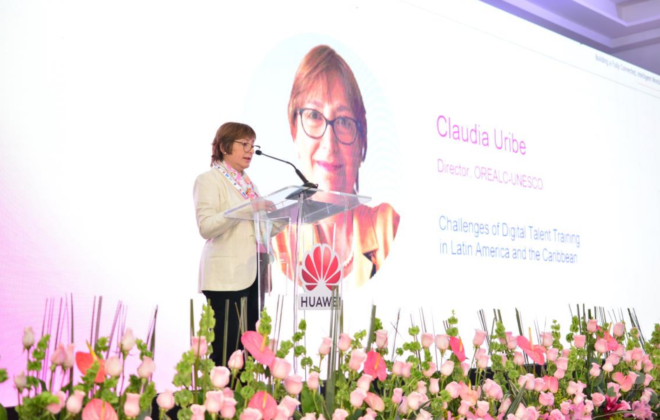CANTO Weekly Newsletter – BNamericas
Thursday, April 26 2018
ICT: The week in 10 stories – Regional
Telefónica posts mixed bag in Q1 as regulations weigh – Regional
Millicom positive on US IPO plans – Regional
Motorola wants to export LatAm success to US, Europe – Regional
Accelerated Mexico growth pushes AT&T Q1 revenue – Mexico, Regional
ICT: The week in 10 stories – Regional
The Brazilian justice ministry, through the national consumer department Senacon, formally opened a case against Facebook regarding the leak of 500,000 Brazilian users’ data in the Cambridge Analytica breach.
Japanese electronics equipment company Furukawa opened a new connectivity plant and distribution center in the city of Curitiba, capital of Brazil’s Paraná state.
MEXICO
Only two groups presented the necessary documents to remain in the race for Mexico’s upcoming 2.5GHz band, out of the five originally interested in the process, the country’s telecom regulator reported.
Mexico’s telecoms regulator, the IFT, fined América Móvil’s mobile unit Telcel 96.8mn pesos (US$5.4mn) after it found it guilty of violating antitrust practices by signing an exclusivity deal with a commercial electronics services company.
ARGENTINA
Spanish telco Telefónica could raise up to US$1bn with the initial public offering of its Argentine subsidiary.
CHILE
Telecom regulator Subtel has given mobile operators until May 1 to eliminate the term “unlimited” from their advertising of broadband plans.
Chile inaugurated the first stretch of a high-capacity fiber optic cable that will be used for processing big data by the country’s astronomical community.
COLOMBIA
Colombia has called on countries in Latin America to do more to address the digital divide, as well as to use technology to boost productivity and for personal data protection.
ITC minister David Luna said that despite the progress made, 44% of Latin Americans still do not have internet access and it is necessary to create the conditions for further rollout of infrastructure and investment.
REGIONAL
AT&T decided to withdraw its planned IPO of Vrio Corp, which holds the company’s DirecTV Latin America and Sky Brasil assets, citing market conditions.
CUBA
Finally, Cuba reached 5mn mobile telephone users, state-owned telephone operator Etecsa said, as the country increases connectivity for its 11mn inhabitants.
Telefónica posts mixed bag in Q1 as regulations weigh – Regional
Spanish group Telefónica posted a 7.2% drop in revenues to 12.2bn euros (US$14.9bn) in Q1, impacted by the “negative impact of regulation,” namely the end of roaming in Europe.
Net profits stood at 837mn euros, up 7.4% from 779mn euros in the same three months of last year.
Telefónica, which reported results a day earlier for its Telefônica Brasil unit, divided its Hispano América operations into north and south at the end of January.
TELEFÓNICA HISPAM SUR
For Telefónica Hispam Sur, which comprises Argentina, Chile, Peru and Uruguay, the company posted 7.6% growth in revenues to 1.83bn euros and 10.8% growth in OIBDA to 517mn euros.
Gains were led by greater penetration of higher value services, increased rates in Argentina and more favorable macroeconomic conditions in general, the company said in a statement.
The gains were offset by competitive intensity in Peru and Chile and the reduction of interconnection rates in Peru.
Income from the mobile data rose 9%, broadband and new services 7.3% and pay-TV 2.8%.
TELEFÓNICA HISPAM NORTE
In the Telefónica Hispam Norte operations, which consists of Colombia, Ecuador, Venezuela, Central America and Mexico, revenues fell 2.2% to 971mn euros, affected by a change in termination rates in Mexico. This was partially offset by positive performances in Ecuador (+8.1%) and Central America (4.3%).
Millicom positive on US IPO plans – Regional
Emerging markets Latin American telecoms operator Millicom is moving ahead with plans to list on a US stock exchange, seeing it as a win-win scenario, according to company CEO Mauricio Ramos.
Speaking during a conference call with investors, Ramos said that the response from its shareholders so far has been positive.
“It would give us enhanced liquidity and access to larger pools of investors, which is positive. For our shareholders a US listing would give them access to dividends in dollars.
“[We’re seeing] little downside apart from some additional cost, it would be good for the business,” Ramos said. The executive added that the company is now at the stage of engaging with external lawyers and accountants and has hired consultants to help with Sarbanes Oxley compliance.
“We’ve had early discussions with the NYSE and the Nasdaq to better understand timing and cost. We see this as something that has tons of benefits, we’re working on it but, as everything else we do, I expect us to be very diligent with this before making a final move on it,” Ramos said.
Millicom reported its first quarter results on April 24, saying group service revenue was up 3.9% in the quarter to US$1.51bn.
Millicom’s Latin American operations include Honduras, Guatemala, El Salvador, Nicaragua, Costa Rica, Colombia, Bolivia and Paraguay, while its African operations are in Chad, Tanzania and Ghana.
The company has been leaning more toward its Latin American operations in recent years. Millicom sold its Congo operations in 2016 and its Senegal unit in 2017. Also in 2017 the company agreed to combine both its Rwanda and Ghana units with Airtel.
Also this week, the company said that the US Justice Department had informed it that it had closed an investigation on “potential improper payments” in relation to its joint venture in Guatemala. The company was suspected of alleged illegal campaign financing and corruption.
Ramos commented that the investigation had closed, finding nothing to indict the company.
Motorola wants to export LatAm success to US, Europe – Regional
Lenovo‘s Motorola is looking to export its Latin American success to other markets, particularly Western Europe, the US and Asia.
This was one of the reasons why the Brazilian, Sérgio Buniac (pictured), who had been leading Motorola’s operations in Latin America, was named president and chairman of the company last month.
Latin America has been a major stronghold for the brand, where it has held on to second place in smartphone sales after Samsung for at least the last four years. In contrast, the company does not even rank among the top five in the global ranking.
In terms of sales, the world smartphone market is ruled by Samsung, Apple and Chinese companies Huawei, Xiaomi and Oppo, according to data from IDC.
In his first public appearance since being appointed CEO, Buniac told reporters in São Paulo that the company’s goal is to continue expanding at a double-digit pace and above the market average in Latin America. Last year, Motorola’s market share in the region hit a record high of 16%, he said.
In Brazil, where over 30mn Moto G phones have been sold, Motorola’s market share is 27%, according to recent data from Gfk. This is twice as much as the third-ranked company, according to the executive. The country is Lenovo’s third most important market in the world.
From 2016 to 2017, Motorola grew 86% in Colombia, compared to average local market growth of 14%; expanded 69% in Central America and the Caribbean (compared to 5% market growth); grew 61% in Mexico (whereas the local market shrank 7%); 22% in Brazil (versus 3% market growth); and 21% in Chile and Peru (compared to 1% market growth).
The company’s highlight last year was Argentina, where sales skyrocketed 112%, compared to local market growth of 22%.
“In Brazil and Argentina we grew strongly mainly because the base of comparison was low. But it was remarkable. And there was Mexico, where smartphones sales fell but we grew,” said Buniac.
Asked by BNamericas whether he thought it was possible to outpace Samsung in sales in Latin America, Buniac said Motorola was not concerned about being number in sales but merely about continuing to grow strongly. “Besides, sometimes we sell more, sometimes Samsung does. In some cities we’re already the leader.”
For 2018, the executive expects Motorola sales to lose a little strength in Brazil and Mexico, citing the economic-political landscape, which is being impacted by national elections. The company targets robust growth rates for Western Europe and the US, the other two key focus regions.
Last year, global smartphone sales declined 0.5%, the first year-on-year decline the market has seen since the introduction of such models.
NEW PHONES
On Thursday, in São Paulo, the company launched a new generation of its successful Moto G family, as well as new Moto E smartphones for the low- to mid-range market. Both models are manufactured in Brazil.
The first Moto G phone was one of those responsible for the brand’s turnaround and success in Latin America, particularly in Brazil.
The launch was global and the phones will first go on sale in its biggest markets in Latin America before gradually reaching the US, Europe and elsewhere. Buniac did not provide sales forecasts.
In Brazil, 90% of sales in Brazil are made via retailers and 10% via mobile operators.
The Moto G6 range includes the standard model with a 5.7-inch full HD screen and 3D glass back, as well as rear 5MP and frontal 12MP cameras and a fingerprint reader. It is now available in Brazil and next week will be on sale in Mexico, before being launched in various countries in Asia Pacific, Europe, Latin America and North America over the coming months. In Brazil, the recommended price is 1,299 reais (US$383).
Also in the new range is the Moto G6 Play, also being launched first in Brazil (1099 reais) and Mexico. It boasts a 4,000mAh battery and 1.4GHz processor with a 5.7-inch display with 720p resolution. At the higher end of the range of the G6 Plus, with a larger 5.9-inch screen with 18:9 ratio, advanced camera software with AR features and f/1.7 aperture for low-light shots. It will sell for 1,599 reais.
The E range targets the lower end of the market, with the 5.7-inch, 6.0-inch E5 Plus and the 5.2-inch E5 Play. The Play model is destined for North America, while the E5 and E5 Plus will be launched in Europe, Asia-Pacific and Latin America. They will go on sale in the coming weeks.
Accelerated Mexico growth pushes AT&T Q1 revenue – Mexico, Regional
A 21% increase in comparable revenues in Mexico pushed US giant AT&T‘s global sales to a 7.1% jump during the first quarter of 2018, as the company’s local unit added 3mn new customers.
AT&T said total revenues for the quarter were US$38bn, of which US$671mn were generated in Mexico. Revenues were “up 14.1% versus the year-earlier quarter, largely due to subscriber growth, which was partially offset by competitive pricing. On a comparable basis, revenues were up 20.9%,” the company said in a statement.
“In the quarter, AT&T added 109,000 postpaid subscribers and 459,000 prepaid subscribers to reach 15.6 million total wireless subscribers in Mexico, a 24% increase from a year ago,” it added. The quarterly growth compared with total wireless additions of 3.2mn.
The company, which recently overtook América Móvil’s network in terms of 4G availability in Mexico, said it plans to reach 10mn subscribers with the faster network by the end of 2018.
AT&T’s main business in Latin America, its DirecTV satellite pay TV service, ended the quarter with revenues of US$1.4bn, and with 13.6 million subscribers.
Earlier this month, AT&T withdrew a planned initial public offering of shares in Vrio, which holds the company’s DirecTV Latin America and Sky Brasil assets, citing market conditions.
The information presented and opinions expressed herein are those of the author and do not necessarily represent the views of CANTO and/or its members.


